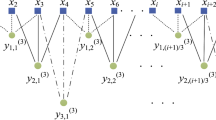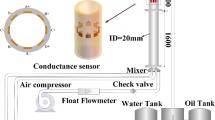Abstract
Oil–water two-phase flow patterns in a horizontal pipe are analyzed with a 16-electrode electrical resistance tomography (ERT) system. The measurement data of the ERT are treated as a multivariate time-series, thus the information extracted from each electrode represents the local phase distribution and fraction change at that location. The multivariate maximum Lyapunov exponent (MMLE) is extracted from the 16-dimension time-series to demonstrate the change of flow pattern versus the superficial velocity ratio of oil to water. The correlation dimension of the multivariate time-series is further introduced to jointly characterize and finally separate the flow patterns with MMLE. The change of flow patterns with superficial oil velocity at different water superficial velocities is studied with MMLE and correlation dimension, respectively, and the flow pattern transition can also be characterized with these two features. The proposed MMLE and correlation dimension map could effectively separate the flow patterns, thus is an effective tool for flow pattern identification and transition analysis.
Similar content being viewed by others
References
ZHANG Jin-jun, LIU Xin. Some advances in crude oil rheology and its application [J]. Journal of Central South University, 2008, 15(s1): 288–292.
MORGAN R G, MARKIDES C N, ZADRAZIL I, HEWITT G F. Characteristics of horizontal liquid–liquid flows in a circular pipe using simultaneous high-speed laser-induced fluorescence and particle velocimetry [J]. International Journal of Multiphase Flow, 2013, 49: 99–118.
MORGAN R G, MARKIDES C N, HALE C P, HEWITT G F. Horizontal liquid–liquid flow characteristics at low superficial velocities using laser-induced fluorescence[J]. International Journal of Multiphase Flow, 2012, 43: 101–117.
LOVICK J, ANGELI P. Droplet size and velocity profiles in liquid–liquid horizontal flows [J]. Chemical Engineering Science, 2004, 59(15): 3105–3115.
ANGELI P, HEWITT G F. Drop size distributions in horizontal oil-water dispersed flows [J]. Chemical Engineering Science, 2000, 55(16): 3133–3143.
SHARIFI M, YOUNG B. Electrical resistance tomography (ERT) applications to chemical engineering [J]. Chemical Engineering Research and Design, 2013, 91(9): 1625–1645.
TAN Chao, DONG Feng, WU Meng. Identification of gas/liquid two-phase flow regime through ERT-based measurement and feature extraction [J]. Flow Measurement and Instrumentation, 2007, 18(5/6): 255–261.
KONG Ling-shuang, YANG Chun-hua, LI Jian-qi, ZHU hong-qiu, WANG Ya-lin. Generic reconstruction technology based on RST for multivariate time series of complex process industries [J]. Journal of Central South University, 2012, 19(5): 1311–1316.
TAN Chao, ZHAO Jia, DONG Feng. Gas-water two-phase flow characterization with electrical resistance tomography and multivariate multiscale entropy analysis [J]. ISA Trans, 2015, 55: 241–249.
CIGNETTI F, DECKER L M, STERGIOU N. Sensitivity of the Wolf’s and Rosenstein’s algorithms to evaluate local dynamic stability from small gait data sets [J]. Annuals of Biomedical Engineering, 2012, 40(5): 1122–1130.
LU Shan, W ANG Hai-yan. Calculation of the maximal Lyapunov exponent from multivariate data [J]. Acta Physica Sinica, 2006, 55(2): 572–576. (in Chinese)
GRASSBERGER P, PROCACCIA I. Characterization of strange attractors [J]. Physical Review Letters, 1983, 50(5): 346–349.
WANG Ji-min, ZHOU Yuan-yuan, LAN Shen, CHEN Tao, LI Jie, YAN Hong-jie, ZHOU Jie-min, TIAN Rui-jiao, TU Yan-wu, LI Wen-ke. Numerical simulation and chaotic analysis of an aluminum holding furnace [J]. Metallurgical and Materials Transactions B, 2014, 45(6): 2194–2210.
DONG Feng, XU Cong, ZHANG Zhi-qiang, REN Shang-jie. Design of parallel electrical resistance tomography system for measuring multiphase flow [J]. Chinese Journal of Chemical Engineering, 2012, 20(2): 1–12.
TAKENS F. Detecting strange attractors in turbulence [M]// RAND D, YOUNG L S. Dynamical Systems and Turbulence. Springer Berlin Heidelberg, 1981: 366–381.
KIM H S, EYKHOLT R, SALAS J D. Nonlinear dynamics, delay times, and embedding windows [J]. Physica D, 1999, 127: 48–60.
GU Jian, CHEN Shu-yan. Nonlinear analysis on traffic flow based on catastrophe and chaos theory [J]. Discrete Dynamics in Nature and Society, 2014: 535167.
ROSENSTEIN M T, COLLINS J J, LUCA C J. A practical method for calculating largest Lyapunov exponents from small data sets [J]. Physica D, 1993, 65: 117–134.
TRALLERO J L, SARICA C, BRILL J P. A study of oil-water flow patterns in horizontal pipes [J]. SPE Production & Facilities, 1997, 12(3): 165–172.
XU Xiao-xuan. Study on oil–water two-phase flow in horizontal pipelines [J]. Journal of Petroleum Science and Engineering, 2007, 59(1/2): 43–58.
TAN Chao, LI Peng-fei, DAI Wei, DONG Feng. Characterization of oil-water two-phase pipe flow with a combined conductivity/capacitance sensor and wavelet analysis [J]. Chemical Engineering Science, 2015, 134: 153–168.
Author information
Authors and Affiliations
Corresponding author
Additional information
Foundation item: Projects(61227006, 61473206) supported by the National Natural Science Foundation of China; Project(13TXSYJC40200) supported by Science and Technology Innovation of Tianjin, China
Rights and permissions
About this article
Cite this article
Tan, C., Wang, Nn. & Dong, F. Oil–water two-phase flow pattern analysis with ERT based measurement and multivariate maximum Lyapunov exponent. J. Cent. South Univ. 23, 240–248 (2016). https://doi.org/10.1007/s11771-016-3067-3
Received:
Accepted:
Published:
Issue Date:
DOI: https://doi.org/10.1007/s11771-016-3067-3




